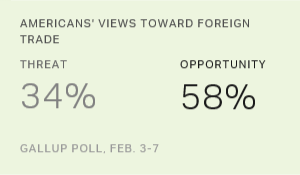Story Highlights
- Americans' confidence in the economy essentially unchanged since July
- Democrats, higher earners remain most confident in U.S. economy
WASHINGTON, D.C. -- Americans' confidence in the U.S. economy has held steady since July. Gallup's Economic Confidence Index averaged -13 in February, within the narrow range of -14 to -11 recorded over the past eight months. Consumers' confidence in the economy is notably lower than a year ago, when the index registered +1 for February -- one of only two positive monthly readings since 2008.
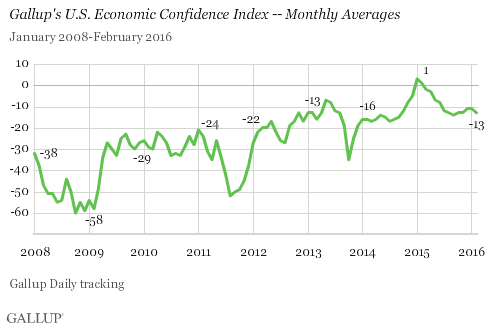
Still, despite economic confidence declining over the past year, consumers remain much more upbeat than they were during the Great Recession and post-recession years of 2009 to 2011.
Gallup's Economic Confidence Index is the average of two components: how Americans rate current economic conditions and whether they believe the economy is getting better or getting worse. The index has a theoretical high of +100, if all Americans rate the current economy as "excellent" or "good" and say it is "getting better." It has a theoretical low of -100, if all Americans rate the current economy as "poor" and say it is "getting worse."
In February, 25% of Americans rated current economic conditions as excellent or good, while 30% rated them as poor, resulting in a current conditions score of -5. Meanwhile, 38% of Americans said the economy is getting better and 58% said it is getting worse, resulting in an economic outlook score of -20 -- among the lowest economic outlook scores recorded in the past year.
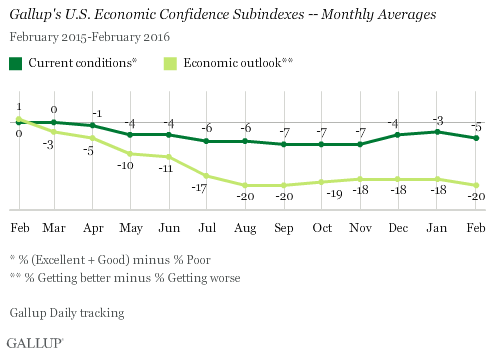
Democrats Remain Positive About Economy
Democrats (+17) remain much more confident than independents (-13) and Republicans (-40) in the economy. Prior to President Barack Obama taking office in 2009, Republicans were much more confident than Democrats.
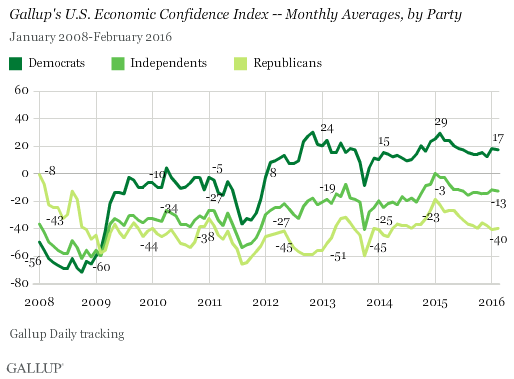
Republicans evaluate current economic conditions -- and, in particular, the economy's direction -- negatively. They have a current conditions score of -23 and an economic outlook score of -57. Democrats are more positive on both components. They have a current conditions score of +19 and an economic outlook score of +14.
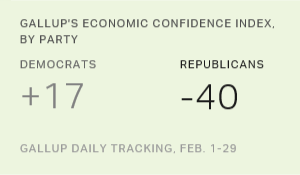
Upper-Income Americans Most Confident in Economy
Americans' confidence in the economy is related to their own financial standing. Adults in high-income households consistently have more confidence in the economy than those in lower-income households.
For all income groups, Gallup's Economic Confidence Index is currently in negative territory. Those who live in households that earn $90,000 or more a year have an index score of -3, while those with annual household incomes under $60,000 have the lowest index scores (-16).
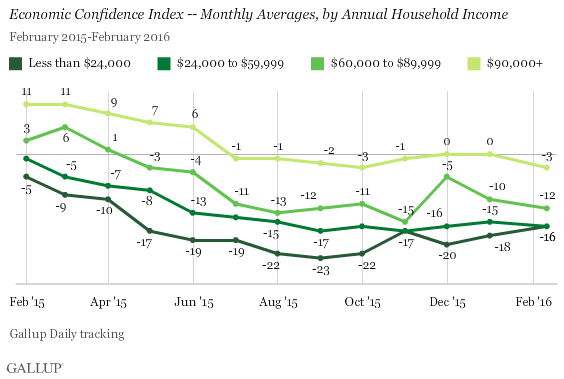
Bottom Line
The unemployment rate as measured by the U.S. Bureau of Labor Statistics is at its lowest point in nearly eight years, and gas prices have been relatively low for over a year. But while Americans are enjoying the prices at the pump, the low prices are also adversely affecting those in the energy industry, which has ripple effects for states that have many energy sector jobs.
The economy as measured by GDP continues to grow, but at a fairly modest rate. And after a steady run of increasing stock values between 2010 and 2015, the stock market has been volatile in recent months and remains considerably below its February 2015 high. This mixture of good and bad economic news is enough to keep Americans slightly more negative than positive about the condition of the U.S. economy.
These data are available in Gallup Analytics.
Survey Methods
Results for this Gallup poll are based on telephone interviews conducted Feb. 1-29, 2016, on the Gallup U.S. Daily survey, with a random sample of 14,169 adults, aged 18 and older, living in all 50 U.S. states and the District of Columbia. For results based on the total sample of national adults, the margin of sampling error is ±1 percentage point at the 95% confidence level. All reported margins of sampling error include computed design effects for weighting.
Each sample of national adults includes a minimum quota of 60% cellphone respondents and 40% landline respondents, with additional minimum quotas by time zone within region. Landline and cellular telephone numbers are selected using random-digit-dial methods.
Learn more about how Gallup Daily tracking works.
